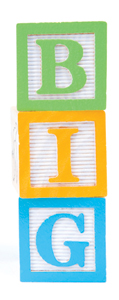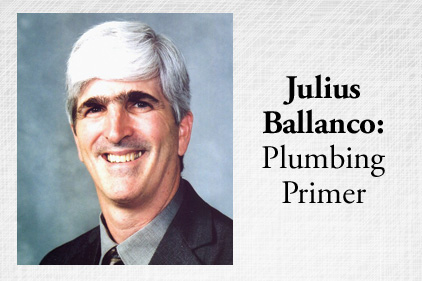
|
|
Photo credit: ©istockphoto.com/photog2112 |
One of my favorite plumbing trivia questions is, “How many water closets can you connect to a 3-in. drain?”
The answer is 16. That’s correct — the International Plumbing Code allows 16 private water closets to connect to 3-in. building drain that is pitched 1/2 in. per foot. Of course, you couldn’t connect any other fixtures to that drain line, so the answer is somewhat unrealistic. However, it does point out how much we are still oversizing drain lines.
As a profession, we have been embedded with the mentality that bigger is better. That is just the way we were raised. And it is not just plumbing contractors with this mentality; it has permeated its way into plumbing engineers’ minds, too. If there is one thing that contractors and engineers tend to agree on, it is that bigger is better.
It was Dr. Al Steele who started a campaign in the 1970s that bigger is not better. Al passed away about 20 years ago. However, his message is still loud and clear. Yet, we don’t want to completely listen to what he had to say.
The first place where “bigger is not better” has been somewhat successful is in residential construction. Many new homes today are piped with 3-in. and smaller drains throughout the residence. However, where we fail is with the connection directly outside. The sewer is increased to 4 in. How many single-family dwellings have you seen with a 3-in. building sewer? I can answer that — none.
Yet almost every home could have a 3-in. sewer. The only time a 4-in. sewer would be justified is when you have a Hollywood home with umpteen bathrooms.
A disconnect exists between the East Coast and the West Coast regarding drain line size. The plumbing codes in the east have embraced smaller drain line sizes. Codes in the west have not. While out east you can have 16 water closets on a 3-in. drain, the West Coast will allow 4 (maybe). The East Coast allows a kitchen sink drain to be 1 1/2 in.; the west requires a 2-in. drain with a 1 1/2 in. trap. Eastern codes allow a shower drain to be 1 1/2 in., while western codes require 2 in. shower drains.
I remember one instructor saying that as soon as you think a drain is large enough, make it even larger. His example was to connect a 1.6-gallon-per-flush water closet to a 10-ft.-diameter drain. The question is, “How far will the solids travel?” The answer is, “They won’t.” The flush will go plop and the solid will just sit there.
That is understandable for a 10-ft.-diameter pipe. But translate that mentality to just a slight increase in size for the drain. The same will occur; the larger you make the pipe, the less the solids will travel. Make the pipe the size allowed (following East Coast mentality) and the solids stay in suspension the entire way.
One of the comments recently made out west regarding the plumbing code was that we need more cleanouts. It is a comical statement because the increase in stoppages is directly related to the oversizing of the drain.
Food disposers, urinals
Some believe this smaller size may be great for residential, but it isn’t any good for commercial plumbing systems. Think about that statement. Does it make any sense? Of course not. The same problem occurs in commercial plumbing systems.
One plumbing contractor whispered to me to not say too much about properly sizing drain lines. He said that his service division makes a lot of money clearly those drains. “If you have them size the drain correctly the first time, I’ll lose money with less drain cleaning,” he said. As much as he was joking with me, that is the truth. Smaller drains translate to less stoppages.
Other comments about commercial plumbing systems include the need for larger drains for food waste disposers and urinals.
There is this thought process that a food waste disposer translates to a pumped waste. Thus, a large drain is justified. This is another misnomer. A food waste disposer is not a pumped waste; the waste stream is the same as any drain. The concern the manufacturers have is oversizing resulting in stoppages. That’s right; with all the chopped-up food waste, you need to maintain proper velocity in the drain to carry the food waste out. Make the drain too big and the chopped-up food waste drops out of suspension.
With urinals, there has been a push toward nonwater-supplied models. But with the “bigger is better” mentality, these nonwater-supplied urinals are being connected to 2-in. drains. Put four nonwater-supplied urinals together and the drain is increased to 3 in.
Let’s think about this. When you really have to empty your bladder, the amount of urine is one pint. So, put four nonwater-supplied urinals together and you have a whopping half a gallon of water going down the drain. That’s in a 3-in. drain. That same 3-in. drain could accept the discharge of 16 water closets flushing 1.6 gal. The drain could really be 1 1/2 in. for those four urinals. If the drain was 1 1/2 in., the plumbing system would work correctly.
One comment made by some plumbing contractors was, “We need the drain larger because these nonwater-supplied urinals are no good and will have to be replaced with normal water-supplied urinals.” Well, if you make the drain that large, you are dooming nonwater-supplied urinals to failure.
Overcoming the “bigger is better” mentality is important in commercial as well as residential construction. Although if you want your service side of the business to keep snaking drain lines, keep oversizing the drains. Otherwise, remember the words of Dr. Al Steele, “Bigger isn’t better!”
HELPFUL LINKS:


